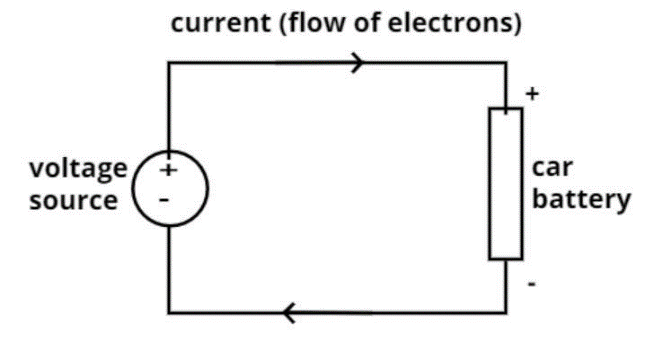
In charging a battery of a motor car, the following effect of electric current is used
A. Magnetic
B. Heating
C. Chemical
D. Induction
Answer
221.1k+ views
Hint:In this question, we use the primary idea of charging that the entity that is to be charged should be at a lower potential in comparison to the source because the flow of electrons will form a higher potential towards a lower potential. The energy that flows between the supply and the body to be charged is saved inside in the form of chemical energy. This will help to get the proper answer.
Complete answer:

As we recognize that the flow of electrons is constantly from higher voltage supply to lower voltage supply. In the case of battery charging of a motor vehicle, the source voltage needs to be more than the battery voltage. In any other case reversal of flow of electrons happens.
In this situation, the battery behaves as a sink so the direction of the current is reversed. So, the source voltage is constantly more than the battery voltage to charge the battery. The energy that's made from voltage, current, and time is saved withinside the battery in the form of chemical energy.
That is, it is primarily based totally at the conversion of electrical energy into chemical energy. According to the conservation of energy, energy can neither be created nor be destroyed; it is simplest transformed from one form into some other form.
The rate of charging the battery is depending on the voltage difference between the source voltage and the battery voltage, the better the difference, the better the rate of charging.
Hence in charging the battery of a motor automobile chemical effect of electrical current is used.
Hence, the correct option is C.
Note:Heating is there every time there is a flow of electrons however it only results in the lack of energy and has no significance in charging. When the electrons moving among different potentials collide with each other there is a lack of kinetic electricity and this accounts to the manufacturing of heat in the system.
Complete answer:

As we recognize that the flow of electrons is constantly from higher voltage supply to lower voltage supply. In the case of battery charging of a motor vehicle, the source voltage needs to be more than the battery voltage. In any other case reversal of flow of electrons happens.
In this situation, the battery behaves as a sink so the direction of the current is reversed. So, the source voltage is constantly more than the battery voltage to charge the battery. The energy that's made from voltage, current, and time is saved withinside the battery in the form of chemical energy.
That is, it is primarily based totally at the conversion of electrical energy into chemical energy. According to the conservation of energy, energy can neither be created nor be destroyed; it is simplest transformed from one form into some other form.
The rate of charging the battery is depending on the voltage difference between the source voltage and the battery voltage, the better the difference, the better the rate of charging.
Hence in charging the battery of a motor automobile chemical effect of electrical current is used.
Hence, the correct option is C.
Note:Heating is there every time there is a flow of electrons however it only results in the lack of energy and has no significance in charging. When the electrons moving among different potentials collide with each other there is a lack of kinetic electricity and this accounts to the manufacturing of heat in the system.
Recently Updated Pages
Young’s Double Slit Experiment Derivation Explained

A square frame of side 10 cm and a long straight wire class 12 physics JEE_Main

The work done in slowly moving an electron of charge class 12 physics JEE_Main

Two identical charged spheres suspended from a common class 12 physics JEE_Main

According to Bohrs theory the timeaveraged magnetic class 12 physics JEE_Main

ill in the blanks Pure tungsten has A Low resistivity class 12 physics JEE_Main

Trending doubts
Understanding Uniform Acceleration in Physics

Understanding Atomic Structure for Beginners

Understanding Entropy Changes in Different Processes

Common Ion Effect: Concept, Applications, and Problem-Solving

Understanding the Wheatstone Bridge: Principles, Formula, and Applications

Formula for number of images formed by two plane mirrors class 12 physics JEE_Main

Other Pages
What Are Elastic Collisions in One Dimension?

Electric field due to uniformly charged sphere class 12 physics JEE_Main

Understanding Charging and Discharging of Capacitors

Free Radical Substitution and Its Stepwise Mechanism

MOSFET: Definition, Working Principle, Types & Applications

Understanding Geostationary and Geosynchronous Satellites




